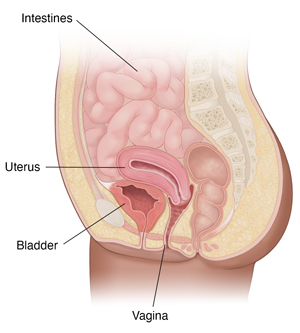Robotic-assisted sacrocolpopexy is a type of surgery. It’s done to repair pelvic organ prolapse. The surgery is done with special tools and a robotic controller.
What is pelvic organ prolapse?
Your pelvis is made up of the bones in the lower part of your belly (abdomen). The uterus, bladder, and lower part of your intestines are just above the pelvic bones. Strong tissues help hold these organs in place. If the tissues weaken, one or more of these organs may drop down and press against or bulge into the vagina. This is called pelvic organ prolapse.
Why robotic-assisted sacrocolpopexy is done
You may need this surgery to relieve symptoms of pelvic organ prolapse, such as:
-
Fullness or pressure in your vagina
-
A bulge of tissue from your vagina
-
Ongoing vaginal discharge or bleeding
-
Trouble urinating
-
Leaking urine with coughing, sneezing, or laughing (stress incontinence)
-
Sudden urges to urinate
-
Trouble having bowel movements
-
Painful sex
Robotic-assisted sacrocolpopexy has some benefits over other types of surgery, such as:
-
Fewer complications
-
A shorter hospital stay
-
A quicker recovery
But it may:
-
Take longer than other surgeries
-
Not be available where you live
-
Cost more
How robotic-assisted sacrocolpopexy is done
The surgery may be done by a gynecologic surgeon. This is a healthcare provider who specializes in female health. Or it may be done by a surgeon who specializes in the urinary system. The surgery can be done in several ways. The surgeon will make a few small cuts (incisions) in the abdomen. The surgeon will pass tools through the small incisions. These include a tiny camera with a light and several robotic tools. If you are going to have a hysterectomy, the surgeon will remove your uterus. The surgeon will lift up the prolapsed part of your vagina. They will sew a tissue graft or synthetic mesh to the vagina. This helps keep the vagina and other organs in place. The graft or mesh is then stitched (sutured) to strong tissue in the pelvic area. The surgeon may also repair other prolapsed pelvic organs. These may include your rectum or bladder.
The FDA has issued a warning about the use of surgical mesh in this type of surgery. Ask your surgeon if they will use mesh and what the risks of using it are.
Risks of robotic-assisted sacrocolpopexy
Every surgery has risks. The risks of this surgery include:
-
Infection
-
Bleeding
-
Blood clots that can travel to the lungs (pulmonary embolism)
-
Injury to nearby organs such as the intestines, bladder, or ureter
-
Problems with cuts (incisions) healing
-
Painful sex
-
Problems with the mesh used to hold organs in place
-
Reaction to medicines used during surgery (anesthesia)
-
Organs or tissue not staying in place and a return of symptoms
-
Need for more surgery
Your risks may vary depending on your age and overall health. They also depend on the location and severity of the prolapse. Talk with your healthcare provider about which risks apply most to you.
Featured in


